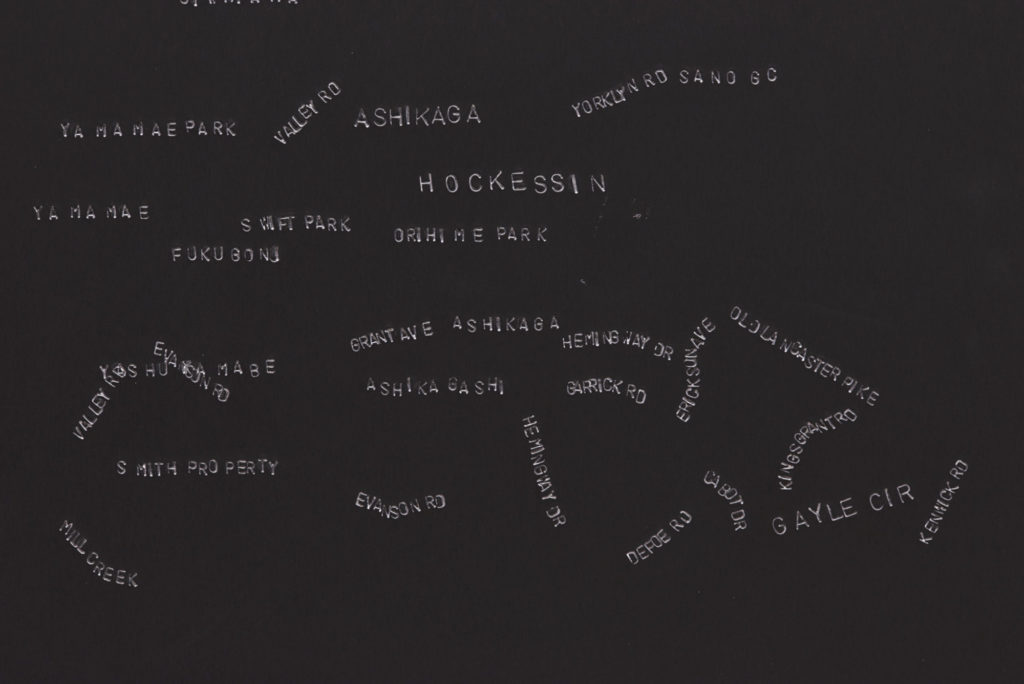In search of the juncture of three coincidental sites
金子未弥 | Miya Kaneko
11 June – 26 August 2018
Opening night reception + publication launch: 11 June, 19:30 – 21:30

© Miya Kaneko, 2018. Dissect the city and achieve oblivion (detail). Aluminium. Size variable, each plate 300 mm × 300 mm × 10 mm. Photo: Hirofumi Tani
|
都市風景をナビゲーションすることは、A・Bといったニ地点間を単純移動することよりも、はるかに多くのことを思い浮かばせる。家から職場までの通勤路といった最もつまらない移動においても、記憶や連想を「まとった」私たちの主観的な解釈は、特定の場所や空間に対する私たちの観点を「飾っている」。新進気鋭の日本人アーティスト金子未弥は、その点を非常に深く理解していると言えよう。アーティストと専門家の両者として彼女は、一都市全体や特定の場所が彼女や他人にとって如何なる意味を持ち得てきたのかと何年も探求してきた。
彼女はここ数年にわたって人や空間の表現方法を画や彫刻など様々な手法を用いて研究している。彼女の取り組みは特定の空間へフォーカスしたことをきっかけに芽生え、「都市とは何からできているのか」という問いへ対する個人的な探求へと変化してきた。特に彼女の制作工程は、個々人が特定の空間を如何に捉えているのかを理解することに重点を置いている。特定の空間へ対して個々人は一体どのように関わっているのだろうか?例えば、彼女の東京は他人の東京と同じものであろうか?当然のことながらこれらの問いへ対する答えとして、都市は人生上の他の問いと同様で、個々人の記憶やアソシエーションに覆われているということである。人はそれぞれ同じ道や空間を取っても、捉え方や考え方が全く異なることがあり、それは個人的なコノテーションや人生経験が道や空間への捉え方や考え方を影響する傾向にあるからである。 このような一空間へ対する個々人の理解の差異は、金子の芸術的実践を刺激するのである。彼女は空間を体験・歴史・アソシエーションの集合体である、記憶のアーカイブとして捉えている。彼女の制作は主に都市的なイメージのある金属を用いているが、それは金属が日常生活において幅広く使用され、多能性や液体化する性質を持っているからである。つまり金子によれば、金属は都市の特質と強く結びついているのである。 コンテナーでの金子の展覧会『同時発生した三空間の接合点を求めて』は、三つの作品を通じて彼女の制作の多様性を披露し、彼女と都市と地図との間の関係性の進展を強調している。最も初期の作品は2013年に作成された「東京」であるが、鉄棒から作られた、東京の巨大な立体地図である。戦後直後と現代の東京の地図などをもとに制作されており、東京の複雑な変化や進化が作品のヒントとなっている。 複雑で多層的なこの彫像は、都市の「血脈」や道路を巨大な蜘蛛の巣のように織り出しており、歴史と記憶の重みが、時間とともに物質的・心理的変化を促進させていることを表現している。彫像は分厚い鉄棒から作られているが、もろさと希薄さも同時に表現されており、作品は大都市の工業的な本質とは対照的な、歴史や記憶の儚い関係性のアレゴリーとしても成立している。 また、『同時発生した三空間の接合点を求めて』は、金子の作品のうちコミュニティから発想を得た二点を展示している。一点目は本展用に制作された大地図「スケールから地図を解放せよ」であり、二点目は様々な都市の名前が彫られたアルミ製の皿のセレクションである(東京ミッドタウンにてグループ・ショーで展示済)。これらの作品は、都市のポートレートや個人のポートレートを造ろうと、多くの人々(ギャラリー来客者、ワークショップ、メール)からのインプットに依ったものである。 「都市を解剖し忘却を得よ」は都市名が彫られた数々のアルミ製の皿であるが、これらは自分にとって重要な都市や空間の地図・説明・関係性を一般人から募ったものである。集められた地図は様々な形をとっている。本物のものや写真のものもあれば、メモや個人の記憶に頼ったものもある。これらは集められた情報によってできた金子自身の理解やアソシエーションからビジュアルな表現として統合、体現されている。 金子の最も新しいプロジェクトである「透明な地図」は、人々の経験と記憶の交わりを更に一歩進めている。想像上であれ、リアルであれ、アソシエーションのリンクや重複は一般人から募った情報を通じて造られ、多様な図形の画は、実体的なコネクションや形を織られることによって完成したのである。透明な「コミュニティ」(金子は「都市」と呼んでいる)は常に変化しており、物理的には実在しないかもしれないが、共有された記憶や経験の超越したことから存在している。都市と都市のマッピング、マッピングによって完成した画は、一般の人々との交流ワークショップで造られているが、おおよそ他人同士の人間によって情報が同時に共有されて造られる「空間」は、常時変化・進化し続けるアソシエーションのリンクや何層もの複雑性が、無限のスケールや形状とともに造られていることからできたものである。 金子未弥の都市と都市のマッピングへ対する熱意は、個人的・歴史的・文化的記憶を統合させているが、これは集合的な記憶を具体化するためであり、また、空間とは、使用に慣れて頼りすぎるようになった、ナビゲーション・システムやスクリーン上のデジタルな地図の一地点よりも大きな意味を持っていることを示すためである。実に空間は、それぞれ多くの人々の経験やアソシエーションから形作られた記憶を持している。
金子未弥:2011年、多摩美術大学を卒業、工芸学学士号を取得。2013年、同大学院より修士号を取得。2017年、同大学院より博士号を取得。同年、多摩美術大学博士課程卒業制作展に出展。2016年、釜山Art District_pのJIGUM展に出展ほか東京KOMAGOME1-14casにて「金子未弥:都市のイメージを求めて」を主催。2017年、東京ミッドタウン・アート・デザイン・コンペティションのグランプリ賞を受賞。同賞によって六本木アート・ナイト2018にて出展を果たす。横浜黄金町を拠点にアーティスト・イン・レジデンスとして現在活躍中。 |
Navigating through cityscapes conjures more than commuting from point A to point B. Even in our most mundane travels, such as going from home to work, subjective interpretations, wrapped in personal memories and associations, dress our perceptions of specific sites and locations. Miya Kaneko, a young up-and-coming Japanese artist, knows it well. She has spent years as an academic and an artist exploring what a city or a given location may mean to her or to others.
Over the last few years she has engaged in a variety of practices that investigate an array of means to map places and people in drawings and sculptures. Her efforts began while focusing on specific locations, over time evolving into a personal investigation of what constitutes a city. Her process centered on how individuals perceive particular places. How do individuals relate to certain sites? Is her Tokyo, for example, the same as someone else’s? The answer is, of course, that cities, like everything else in life, are cladded with personal memory and associations. Different entities may have a completely different understanding and reflection of exactly the same route or place. Each, predisposed to personal connotations and life experiences. Those private understandings individuals experience of the same place trigger Kaneko’s art practice. She views locations as a memory archive, constructed of experiences, histories, and associations. She often works with metal, as the material carries an industrial “city-like” connotation, but also for its wide usage in everyday life (from construction to farming), its versatility and ability to liquify — all associated, in Kaneko’s mind, with the qualities of a city. Miya Kaneko’s exhibition at The Container, In search of the juncture of three coincidental sites, showcases three pieces of work from different points of her practice, highlighting the progression of her relationship with cities and maps. The earliest piece the show is presenting is a large three-dimensional map of Tokyo, entitled Tokyo (2013), constructed from iron rods. The sculpture is based on reference maps from postwar Tokyo and current maps of the city; inspired by the changes and complex evolution of Tokyo during that period of time. The sculpture is delicately complex and layered, weaving arteries of the city and changing roads, like a humongous spider web, illustrating how the weight of history and memory facilitate physical and emotional change over time. Although the structure is constructed from solid iron rods, it projects fragility and tenuousness, and is an allegory to the relationship between the industrial nature of large cities in contrast to their tentative histories and memory. In search of the juncture of three coincidental sites features also two interconnected community-inspired projects by Kaneko. One, a drawing, a large-sized map, Kaneko has produced especially for The Container, Release the map from the scale; and the other, is a selection of aluminum plates engraved with city names (recently exhibited in a large group show at Tokyo Midtown). Both of these projects rely on input the artist receives from the public (gallery visitors / workshops / emails) in an effort to produce a portrait of a city, or a portraits of individuals. In the aluminium drawings, Dissect the City and Achieve Oblivion, plates of aluminium engraved with city names, members of the public are requested to contribute a map of an important site / city, along with a description of the place and their relation to it. The “maps” may take many forms—actual ones, or photographs, or even notes and personal recollections from a certain location. Those are integrated by Kaneko to create visual representations inspired by her own understanding and associations with the information collected. Kaneko’s newest project, Invisible map, takes the the intersection between different peoples’ experiences and memories a step further. Through data provided by members of the public, associative links and overlaps are forged, imagined and real, to fabricate tangible connections and shapes, resulting in a drawing, a diagram of sorts. The evolving invisible “community” (Kaneko calls it a “city”) perhaps does not exist physically, but transcends from shared cognitive memory and experience. These cities, and their mapping, the resulting drawings, are produced through interactive workshops with members of the public, in an effort to build bespoke “spaces” where data is shared simultaneously by a variety of seemingly unconnected people, forging associative links and adding layers of complexity that are forever changing and evolving, with indefinite scale or configurations. Miya Kaneko’s preoccupation with cities and mapping joins personal, historical and cultural recollections to flesh out a collective memory, and to remind us that places are more than a pin on the ubiquitous GPS-controlled digital maps we have grown so accustomed to and dependent on. Places have memory of their own, cultivated by the experiences and associations of many.
Miya Kaneko graduated in 2011 from Tama Art University with a bachelor’s degree in metal works. She obtained a master’s degree in art in 2013, and Ph.D. in 2017 at Tama Art University Graduate School of Art and Design. Her recent exhibitions include Tama Art University Doctoral Program Graduation Exhibition at Tama Art University Museum in Tokyo, 2017; JIGUM exhibition at Art District_p in Busan, South Korea, 2016; and Kaneko Miya: Searching for the Image of Cities at KOMAGOME1-14cas in Tokyo, 2016. She has recently also won the Grand Prize Award of Tokyo Midtown Art and Design Competition (2017), and exhibited last May as part of Roppongi Art Night 2018. She is currently an artist-in-residence at Koganecho, Yokohama. |